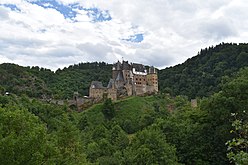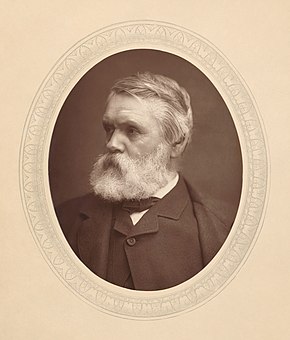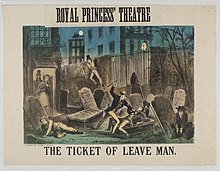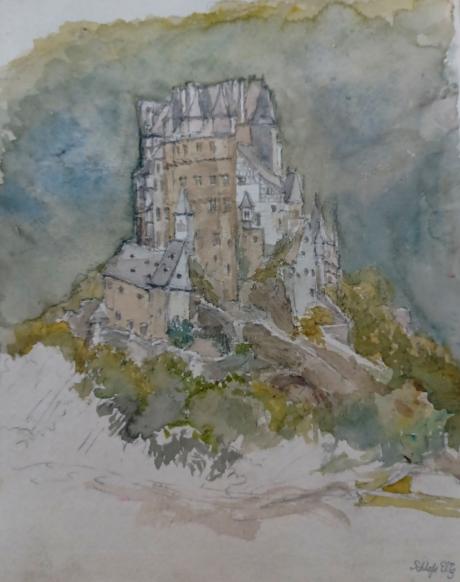inscribed and dated "Eltz Castle Eltz Schloss 1876" and signed with initials "TT"
Tom and Laura Taylor and thence by descent
Eltz Castle is a medieval castle nestled in the hills above the Moselle between Koblenz and Trier, Germany. It is still owned by a branch of House of Eltz who have lived there since the 12th century. Eltz Castle along with Bürresheim Castle and Lissingen Castle are the only castles in the Eifel region which have never been destroyed.
The castle stands on a 70-metre-high (230 ft) rock spur that is bounded on three sides by the river Elzbach, a tributary on the north side of the Moselle. The surrounding Eltz Forest has been declared a nature reserve by Flora-Fauna-Habitat and Natura 2000.

The castle is a so-called Ganerbenburg, or castle belonging to a community of joint heirs. This is a castle divided into several parts, which belong to different families or different branches of a family; this usually occurs when multiple owners of one or more territories jointly build a castle to house themselves. Only wealthy medieval European lords could afford to build castles or equivalent structures on their lands; many of them only owned one village or even only part of a village. This was an insufficient base to afford castles. Such lords usually lived in "knight's houses", which were fairly simple houses, scarcely bigger than those of their tenants. In some parts of the Holy Roman Empire of the German Nation, inheritance law required that the estate be divided among all successors. These successors, each of whose individual inheritance was too small to build a castle of his own, could build a castle together, where each owned one separate part for housing, and all of them together shared the defensive fortification. In the case of Eltz, the family comprised three branches and the existing castle was enhanced with three separate complexes of buildings.
The main part of the castle consists of the family portions. At up to eight stories, these eight towers reach heights of between 30 and 40 metres (98 and 131 ft). They are fortified with strong exterior walls; to the yard, they present a partial framework. About 100 members of the owners' families lived in the over 100 rooms of the castle. A village once existed below the castle, on its south side, which housed servants, craftsmen, and their families supporting the castle.

The castle was founded in a region that was an important trade route between rich farmlands and their markets in the Roman period. With the collapse of the Western Roman Empire in the late 5th Century BE, the area was conquered by the Franks. However with the division of Charlemagne's empire the land was given to his son Louis the Pious (814). It was during this period that the site was occupied by a simple manor hall with an earthen palisade.
Several hundred years later, House of Eltz began work on the Platteltz, a Romanesque keep, which was built on the site of the old manor hall. This remains the oldest part of the castle. By 1157 the fortress was an important part of the Holy Roman Empire under Frederick Barbarossa. It continued to protect the trade routes from the Moselle Valley and the Eifel region.
Between 1331–1336, the castle endured the only serious military conflicts in its history during the Eltz Feud when lords in the region including Johann of Eltz, together with free imperial knights, opposed the territorial policies of Balduin von Trier who was the Elector and Prince-Archbishop of Trier. As a result of the standoff, Balduin lay siege to Johann at Eltz Castle. It was bombarded by primitive cannons known as Pot-de-fer and catapults from a small siege castle, Trutzeltz Castle, which was built on a rocky outcrop on the hillside above the castle (the remains can still be seen today as a few ruined walls on the northern side of the castle). The siege of Eltz ended after two years when the free imperial knights agreed to accept the laws and sovereignty of Trier. Archbishop Balduin reinstated Johann to the Burgrave, but only as his vassal and no longer as a free knight.

Started in 1470 by Philipp zu Eltz, the 10-story Greater Rodendorf House takes its name from the family's land holding in Lorraine. The oldest part is the flag hall with its late Gothic vaulted ceiling, which was probably originally a chapel. Construction was completed around 1520. The (so-called) Little Rodendorf house was finished in 1540, also in Late Gothic style. It contains the vaulted "banner-room". In 1472 the House of Rübenach completed the castle wing that has Late Gothic architecture. The buildings include the Rübenach Lower Hall, living room, and the bedchamber with its opulently decorated walls.
In 1615 the House of Kempenich house replaced castle's original hall. Every room in this part of the castle could be heated; in contrast, other castles might only have one or two heated rooms.
During the Palatinate War of Succession from 1688 to 1689, many of the early Rhenish castles were destroyed. However, the castle was saved from destruction because its lord as the time was Hans Anton zu Eltz-Üttingen who was also a senior officer in the Royal French Army of Louis XIV. Eltz-Üttingen was able to use his position to delete the castle bearing his name from the list of buildings and fortifications to be destroyed.
Count Hugo Philipp zu Eltz was thought to have fled during the French rule on the Rhine from 1794 to 1815. The French confiscated his possessions on the Rhine and nearby Trier which included Eltz castle, as well as the associated goods which were held at the French headquarters in Koblenz. In 1797, when Count Hugo Philipp later turned out to have remained hidden in Mainz, he came back to reclaim his lands, goods and wealth. In 1815 he became the sole owner of the castle through the purchase of the Rübenacher house and the landed property of the barons of Eltz-Rübenach.

In the mid 19th century, Count Karl zu Eltz restored the castle. Between 1845 and 1888, 184,000 marks (equivalent to €2,680,000 in 2021) was spent on extensive construction work that carefully preserved the existing architecture.
Extensive security and restoration work took place between the years 2009 to 2012. Among other things, the vault of flags hall was secured after it was at risk of partially collapsing walls and the porch of the Kempenich section. In addition to these static repairs, almost all the slate roofs were replaced. Structural problems were remedied in the ceiling and wood damage was repaired. In the interior, heating and sanitary facilities, windows and fire alarm system were renewed, and also historic plaster was restored. The half-timbered facades and a spiral staircase were renovated at the costs of around €4.4 million. The measures were supported by a €2 million grant from an economic stimulus package provided by the German federal government. The state of Rhineland-Palatinate, the German Foundation for Monument Protection and the owners provided further funds.
The Rübenach and Rodendorf family wings in the castle are open to the public, while the Kempenich branch continue to use their third of the castle. Public visits are seasonal: from April to November. Exhibits include the treasury, which contains gold, silver and porcelain artifacts, and the armory which hosts historic weapons and suits of armor.

From 1965 to 1992, an engraving of Eltz Castle was used on the German 500 Deutsche Mark note.
The castle was used as the exterior for the fictional American military lunatic asylum in the 1979 William Peter Blatty movie, The Ninth Configuration, starring Stacy Keach.
The opening sequences of Le Feu de Wotan, a Belgian bande dessinée (comic book) in the Yoko Tsuno series, take place in Eltz Castle. Eltz castle also inspired the castle featured chiefly on the Himmelsdorf map and its winter derivative of the MMO World of Tanks. The model of the castle is also reused on the maps Westfield and Erlenberg.
Eltz Castle decorates the homepage of the German Whitepages as a symbol of German culture next to BMW, Nivea Cream, a Thurn and Taxis postcoach or the facade of Deutsches Museum.
The Eltz Castle (ingame name Elzbach Palace) is the Defensive Imperial Age Landmark of the Holy Roman Empire Civilization in Age of Empires IV.

Tom Taylor (19 October 1817 – 12 July 1880) was an English dramatist, critic, biographer, public servant, and editor of Punch magazine. Taylor had a brief academic career, holding the professorship of English literature and language at University College, London in the 1840s, after which he practised law and became a civil servant. At the same time he became a journalist, most prominently as a contributor to, and eventually editor of Punch.
In addition to these vocations, Taylor began a theatre career and became best known as a playwright, with up to 100 plays staged during his career. Many were adaptations of French plays, but these and his original works cover a range from farce to melodrama. Most fell into neglect after Taylor's death, but Our American Cousin (1858), which achieved great success in the 19th century, remains famous as the piece that was being performed in the presence of Abraham Lincoln when he was assassinated in 1865.
Early years
Taylor was born into a newly wealthy family at Bishopwearmouth, a suburb of Sunderland, in north-east England. He was the second son of Thomas Taylor (1769–1843) and his wife, Maria Josephina, née Arnold (1784–1858). His father had begun as a labourer on a small farm in Cumberland and had risen to become co-owner of a flourishing brewery in Durham. After attending the Grange School in Sunderland, and studying for two sessions at the University of Glasgow, Taylor became a student of Trinity College, Cambridge in 1837, was elected to a scholarship in 1838, and graduated with a BA in both classics and mathematics. He was elected a fellow of the college in 1842 and received his MA degree the following year.

Taylor left Cambridge in late 1844 and moved to London, where for the next two years he pursued three careers simultaneously. He was professor of English language and literature at University College, London, while at the same time studying to become a barrister, and beginning his life's work as a writer. Taylor was called to the bar of the Middle Temple in November 1846. He resigned his university post, and practised on the northern legal circuit until he was appointed assistant secretary of the Board of Health in 1850. On the reconstruction of the board in 1854 he was made secretary, and on its abolition in 1858 his services were transferred to a department of the Home Office, retiring on a pension in 1876.
Writer
Taylor owed his fame and most of his income not to his academic, legal or government work, but to his writing. Soon after moving to London, he obtained remunerative work as a leader writer for the Morning Chronicle and the Daily News. He was also art critic for The Times and The Graphic for many years. He edited the Autobiography of B. R. Haydon (1853), the Autobiography and Correspondence of C. R. Leslie, R.A. (1860) and Pen Sketches from a Vanished Hand, selected from papers of Mortimer Collins, and wrote Life and Times of Sir Joshua Reynolds (1865). With his first contribution to Punch, on 19 October 1844, Taylor began a thirty-six year association with the magazine, which ended only with his death. During the 1840s he wrote on average three columns a month; in the 1850s and 1860s this output doubled. His biographer Craig Howes writes that Taylor's articles were generally humorous commentary or comic verses on politics, civic news, and the manners of the day. In 1874 he succeeded Charles William Shirley Brooks as editor.
Taylor also established himself as a playwright and eventually produced about 100 plays. Between 1844 and 1846, the Lyceum Theatre staged at least seven of his plays, including extravanzas written with Albert Smith or Charles Kenney, and his first major success, the 1846 farce To Parents and Guardians. The Morning Post said of that piece, "The writing is admirable throughout – neat, natural and epigrammatic". It was as a dramatist that Taylor made the most impression – his biographer in the Dictionary of National Biography (DNB) wrote that in writing plays Taylor found his true vocation. In thirty-five years he wrote more than seventy plays for the principal London theatres.

A substantial portion of Taylor's prolific output consisted of adaptations from the French or collaborations with other playwrights, notably Charles Reade. Some of his plots were adapted from the novels of Charles Dickens or others. Many of Taylor's plays were extremely popular, such as Masks and Faces, an extravaganza written in collaboration with Reade, produced at the Haymarket Theatre in November 1852. It was followed by the almost equally successful To Oblige Benson (Olympic Theatre, 1854), an adaptation from a French vaudeville. Others mentioned by the DNB are Plot and Passion (1853), Still Waters Run Deep (1855) and The Ticket-of-Leave Man (based on Le Retour de Melun by Édouard Brisebarre and Eugène Nus), a melodrama produced at the Olympic in 1863.Taylor also wrote a series of historical dramas (many in blank verse), including The Fool’s Revenge (1869), an adaption of Victor Hugo's Le roi s'amuse (also adapted by Verdi as Rigoletto), 'Twixt Axe and Crown (1870), Jeanne d'arc (1871), Lady Clancarty (1874) and Anne Boleyn (1875). The last of these, produced at the Haymarket in 1875, was Taylor's penultimate piece and only complete failure. In 1871 Taylor supplied the words to Arthur Sullivan's dramatic cantata, On Shore and Sea.
Like his colleague W. S. Gilbert, Taylor believed that plays should be readable as well as actable; he followed Gilbert in having copies of his plays printed for public sale. Both authors did so at some risk, because it made matters easy for American pirates of their works in the days before international copyright protection. Taylor wrote, "I have no wish to screen myself from literary criticism behind the plea that my plays were meant to be acted. It seems to me that every drama submitted to the judgment of audiences should be prepared to encounter that of readers".

Many of Taylor's plays were extremely popular, and several survived into the 20th century, although most are largely forgotten today. His Our American Cousin (1858) is now remembered chiefly as the play Abraham Lincoln was attending when he was assassinated, but it was revived many times during the 19th century with great success. It became celebrated as a vehicle for the popular comic actor Edward Sothern, and after his death, his sons, Lytton and E. H. Sothern, took over the part in revivals.
Howes records that Taylor was described as "of middle height, bearded [with] a pugilistic jaw and eyes which glittered like steel". Known for his remarkable energy, he was a keen swimmer and rower, who rose daily at five or six and wrote for three hours before taking an hour's brisk walk from his house in Wandsworth to his Whitehall office.
Some, like Ellen Terry, praised Taylor's kindness and generosity; others, including F. C. Burnand, found him obstinate and unforgiving. Terry wrote of Taylor in her memoirs:
Most people know that Tom Taylor was one of the leading playwrights of the 'sixties as well as the dramatic critic of The Times, editor of Punch, and a distinguished Civil Servant, but to us he was more than this. He was an institution! I simply cannot remember when I did not know him. It is the Tom Taylors of the world who give children on the stage their splendid education. We never had any education in the strict sense of the word yet through the Taylors and others, we were educated.
Terry's frequent stage partner, Henry Irving said that Taylor was an exception to the general rule that it was helpful, even though not essential, for a dramatist to be an actor to understand the techniques of stagecraft: "There is no dramatic author who more thoroughly understands his business".
In 1855 Taylor married the composer, musician and artist Laura Wilson Barker (1819–1905). She contributed music to at least one of his plays, an overture and entr'acte to Joan of Arc (1871), and harmonisations to his translation Ballads and Songs of Brittany (1865). There were two children: the artist John Wycliffe Taylor (1859–1925) and Laura Lucy Arnold Taylor (1863–1940). Taylor and his family lived at 84 Lavender Sweep, Battersea, where they held Sunday musical soirees. Celebrities who attended included Lewis Carroll, Charles Dickens, Henry Irving, Charles Reade, Alfred Tennyson, Ellen Terry and William Makepeace Thackeray.
Taylor died suddenly at his home in 1880 at the age of 62 and is buried in Brompton Cemetery. After his death, his widow retired to Coleshill, Buckinghamshire, where she died on 22 May 1905.

